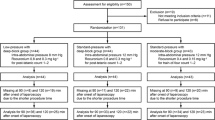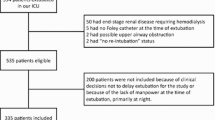Abstract
Purpose
High pressure peaks might be a risk factor for the development of abdominal hernia. The course of abdominal pressure during extubation remains unclear. This preliminary study assessed the impact of two established extubation techniques.
Methods
Twenty-four consecutive patients suffering from abdominal wall hernia with the indication for surgical treatment were included. Twelve patients were extubated directly after the intravenous anaesthesia was stopped, before they had spontaneous breathing (deep extubation). The other 12 were extubated after they had spontaneous breathing (awake extubation). Intra-abdominal pressure (IAP) was measured via bladder catheter continuously.
Results
The highest value during extubation as well as the main increase in IAP was significantly lower in patients who underwent deep extubation (p < 0.001).
Conclusions
Therefore, this extubation technique might improve the outcome of hernia repair.


Similar content being viewed by others
References
Cheatham ML et al (2004) Long-term physical, mental, and functional consequences of abdominal decompression. J Trauma 56(2):237–241 (discussion 241–2)
Smith C, Cheatham ML (2011) Intra-abdominal hypertension and abdominal compartment syndrome in the medical patient. Am Surg 77(Suppl 1):S67–S71
Schein M et al (1995) The abdominal compartment syndrome: the physiological and clinical consequences of elevated intra-abdominal pressure. J Am Coll Surg 180(6):745–753
Sanchez NC et al (2001) What is normal intra-abdominal pressure? Am Surg 67(3):243–248
Cobb WS et al (2005) Normal intraabdominal pressure in healthy adults. J Surg Res 129(2):231–235
Iqbal A et al (2008) A study of intragastric and intravesicular pressure changes during rest, coughing, weight lifting, retching, and vomiting. Surg Endosc 22(12):2571–2575
Iqbal A et al (2006) Assessment of diaphragmatic stressors as risk factors for symptomatic failure of laparoscopic nissen fundoplication. J Gastrointest Surg 10(1):12–21
Fusco MA, Martin RS, Chang MC (2001) Estimation of intra-abdominal pressure by bladder pressure measurement: validity and methodology. J Trauma 50(2):297–302
De Keulenaer BL, Regli A, Malbrain ML (2011) Intra-abdominal measurement techniques: is there anything new? Am Surg 77(Suppl 1):S17–S22
Malbrain ML (2004) Different techniques to measure intra-abdominal pressure (IAP): time for a critical re-appraisal. Intensive Care Med 30(3):357–371
Cannon DJ, Casteel L, Read RC (1984) Abdominal aortic aneurysm, Leriche’s syndrome, inguinal herniation, and smoking. Arch Surg 119(4):387–389
Cannon DJ, Read RC (1981) Metastatic emphysema: a mechanism for acquiring inguinal herniation. Ann Surg 194(3):270–278
Jorgensen LN et al (1998) Less collagen production in smokers. Surgery 123(4):450–455
Abramson JH et al (1978) The epidemiology of inguinal hernia. A survey in western Jerusalem. J Epidemiol Community Health 32(1):59–67
Rutkow IM (1998) Epidemiologic, economic, and sociologic aspects of hernia surgery in the United States in the 1990s. Surg Clin North Am 78(6):941–951 (pp v–vi)
Lau B et al (2012) Obesity increases the odds of acquiring and incarcerating noninguinal abdominal wall hernias. Am Surg 78(10):1118–1121
Le Huu Nho R et al (2012) Incidence and prevention of ventral incisional hernia. J Visc Surg 149(5 Suppl):e3–e14
Sugerman H et al (1997) Intra-abdominal pressure, sagittal abdominal diameter and obesity comorbidity. J Intern Med 241(1):71–79
Ejike JC, Bahjri K, Mathur M (2008) What is the normal intra-abdominal pressure in critically ill children and how should we measure it? Crit Care Med 36(7):2157–2162
Basterra Longás A, Arizcun González S, Erdozain Ríos B (2008) Abviser Kit intra-abdominal pressure monitoring. Revista de enfermería 31(10):43–44
Gudmundsson FF et al (2002) Comparison of different methods for measuring intra-abdominal pressure. Intensive Care Med 28(4):509–514
Yol S et al (1998) Is urinary bladder pressure a sensitive indicator of intra-abdominal pressure? Endoscopy 30(9):778–780
Conflict of interest
The authors RN, EN, CG, TW, FR and CH declare no conflict of interest.
Author information
Authors and Affiliations
Corresponding author
Rights and permissions
About this article
Cite this article
Nemecek, R., Nemecek, E., Glaser, C. et al. Impact of two extubation techniques on the intra-abdominal pressure: a preliminary study. Hernia 19, 307–311 (2015). https://doi.org/10.1007/s10029-014-1230-z
Received:
Accepted:
Published:
Issue Date:
DOI: https://doi.org/10.1007/s10029-014-1230-z




